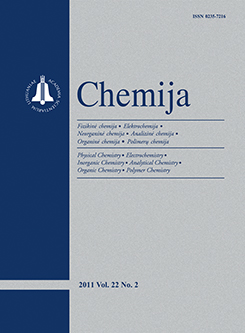 ISSN 0235-7216 ISSN 2424-4538 (online) |
2010 m. Nr. 2-4 Study of electrode kinetics and thermodynamics of zinc complexes with some L-amino acids and vitamin C by voltammetric technique
A simple and highly sensitive direct polarographic method was developed for determining the stability of ternary complexes of Zn2+ employing L-lysine, L-ornithine, L-threonine, L-serine, L-phenylglycine, L-phenylalanine, L-glutamic acid, L-aspartic acid and vitamin C (L-ascorbic acid) at pH = 7.30 ± 0.01, and I = 1.0 M NaClO4 at 25 and 35 °C. The nature of current voltage curves was quasireversible and diffusion-controlled. Zn2+ formed 1 : 1 : 1, 1 : 1 : 2 and 1 : 2 : 1 complexes with these drugs as confirmed by the Schaap and McMaster method. The sequence of the stability constant of L-lysine < L-ornithine < L-threonine < L-serine < L-phenylglycine < L-phenylalanine < L-glutamic acid < L-aspartic acid complexes can be explained on the basis of size, basicity and steric hindrance of ligands. The values of the stability constant (log β) varied from 2.45 to11.45 and confirmed that these drugs, i. e. L-amino acids or in combination with vitamin C or their complexes, could be used against Zn2+ toxicity. The thermodynamic parameters such as enthalpy (ΔH), free energy (ΔG) and entropy change (ΔS) are also reported. The kinetic parameters viz. the transfer coefficient (α), the degree of irreversibility (λ), the diffusion coefficient (D) and the standard rate constant (k) were calculated. The values of α confirmed the symmetric nature of the ‘activated complex’ between oxidants and reductants in response to the applied potential between the dropping mercury electrode and the solution interface. Keywords: voltammetry, thermodynamic parameters, electrode kinetics, Zn–L-amino acidate-vitamin C complexes |
Issues:
2017 - Vol.28 No. 1, No. 2, No. 3, No. 4 2016 - Vol.27 No. 1, No. 2, No. 3, No. 4 2015 - Vol.26 No. 1, No. 2, No. 3, No. 4 2014 - Vol.25 No. 1, No. 2, No. 3, No. 4 2013 - Vol.24 No. 1, No. 2, No. 3, No. 4 2012 - Vol.23 No. 1, No. 2, No. 3, No. 4 2011 - Vol.22 No. 1, No. 2, No. 3, No. 4 2010 - Vol.21 No. 1, No. 2-4 2009 - Vol.20 No. 1, No. 2, No. 3, No. 4 2008 - Vol.19 No. 1, No. 2, No. 3-4 2007 - Vol.18 No. 1, No. 2, No. 3, No. 4 2006 - Vol.17 No. 1, No. 2-3, No. 4 2005 - Vol.16 No. 1, No. 2, No. 3-4 2004 - Vol.15 No. 1, No. 2, No. 3, No. 4 2003 - Vol.14 No. 1, No. 2, No. 3, No. 4 2002 - Vol.13 No. 1, No. 2, No. 3, No. 4 2001 - Vol.12 No. 1, No. 2, No. 3, No. 4 |